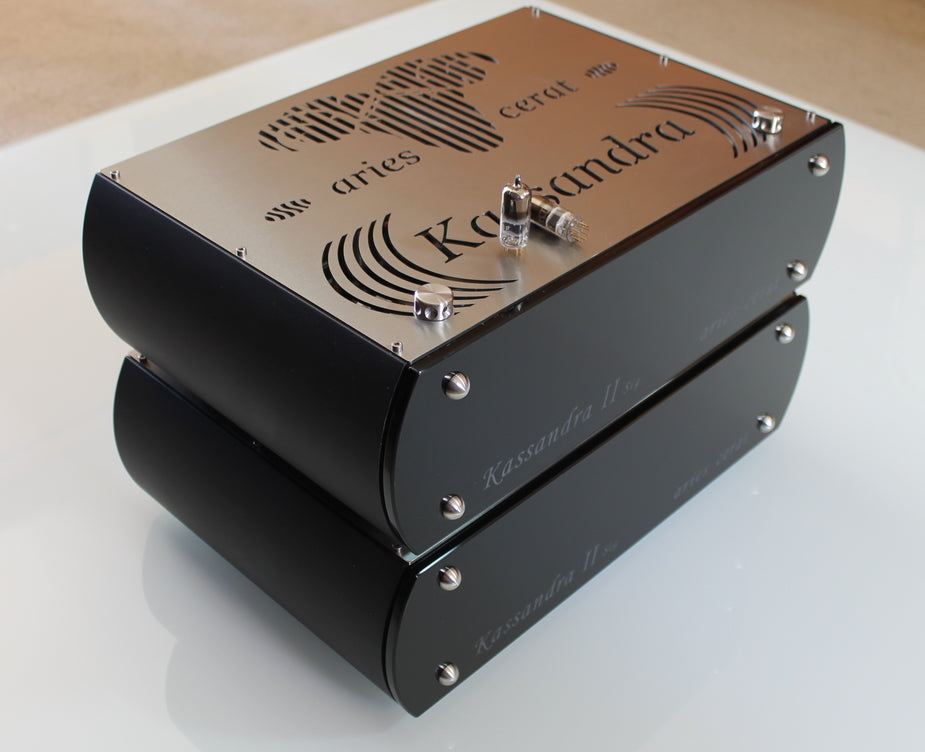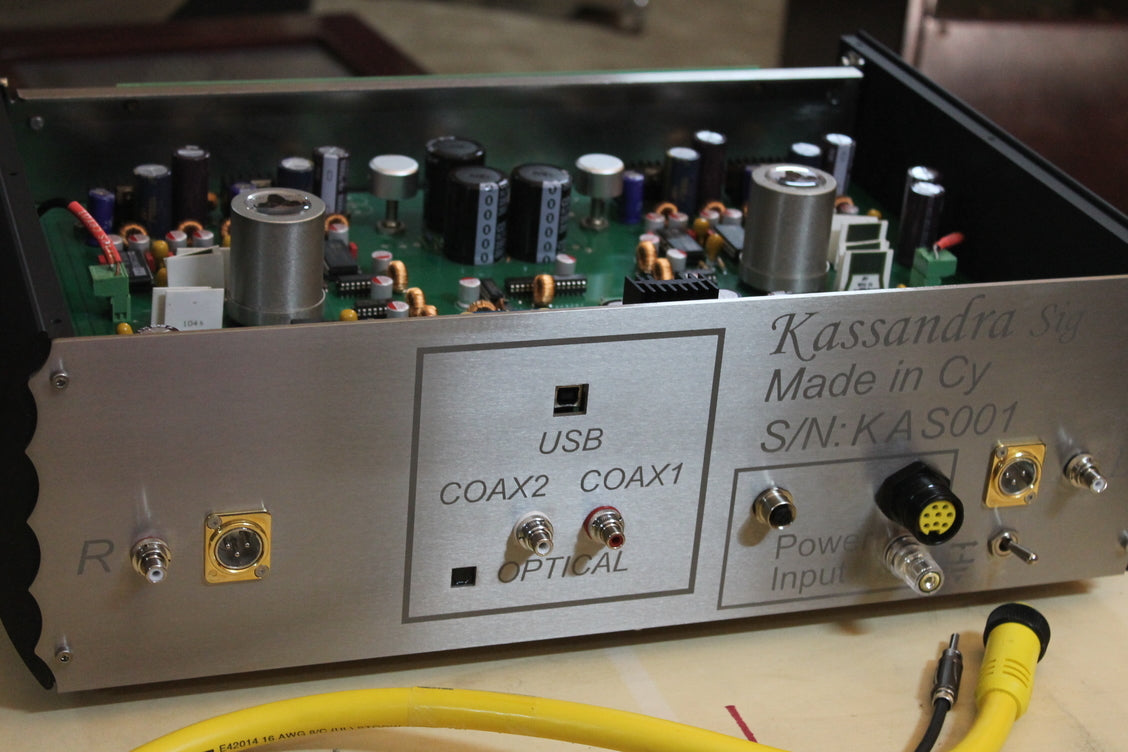



Details
Description
The Kassandra Signature is our two chassis version in the Kassandra Series and completely redefines the status of digital replay.
Designing the Kassandra
Our approach in designing the Kassandra Signature, was to build on our already SOTA performing Kassandra II Ref, and push the boundaries further. Adopting a 2 chassis design approach along the lines of our amplifiers in the Signature range allowed extra freedom and space. We employed many techniques that proved so successful in our Impera Signature preampliifer, particularly in the power supply unit.
Ladder DAC
The Kassandra Signature Limited is a ladder DAC. Typically a ladder DAC uses a resistor network switched by a N number of switches, N being the bit depth. It is a passive sort of speak procedure with no manipulation of the incoming data stream.
It also has no digital filter, and completely avoids the negative sonic aspects created by fitting the common Delta-Sigma or Multibit architecture.
In the case of the Kassandra Signature we choose to use an R2R IC – the classic Analogue Devices AD1865N-K, a much praised chip which we believe is the best sounding IC ever made. No less than 20 R2R converters per channel. The AD1865N-K has a very straight forward data handling logic, and does not process the data stream in any way. This gave us the freedom to fully exploit the IC in our converter system.
The input data is latched and directly refreshes the resistor network, with absolutely no additional complex logic or data handling/processing. This way we have full control over the resistor network to use it as part of our converter system. Our Super Clock circuit directly re-clocks and drives the “refresh” signal, so absolutely no additional jitter is induced in the conversion.
The 20 R2R converters per channel in the Kassandra Signature are working as parallel switched resistor ladder converters, cancelling the deviation of resistor values down to Zero. Paralleling R2R converters improves linearity and noise figures are improved on the same principles, along with the dynamic range and channel separation. Sonic wise, paralleling converters elevate performance to another level in all aspects significant in high end audio.
Jitter
In the Kassandra Signature we use many techniques regarding lowering and cancelling jitter, in both passive and active ways. Bouncing signals, overshoots, low rise times etc greatly increase jitter. We solve this by using special driving circuits and carefully tuned digital line terminations for all digital signals.
We use 30 LC filters implemented using RF chokes and high speed capacitors to decouple digital circuits and ICs from the power rails. These are extremely effective in cancelling out any form of PSU sourced jitter and solve this fairly complex problem. Jitter originated in USB and S/PDIF / Toslink sources are eliminated right at the “refresh” signal of the converters.
Having an IC that has no complex data handling logic and no multi stage data logic, the precisely timed signal resolves in a extremely accurate jitter free conversion. In our opinion, this is not possible with any other type of converter system.
The Super Clock is also used upstream for re-clocking the XMOS asynchronous USB controller, as well as the SPDIF receiver. With the internal clock, there is no need for a word clock input.
I/V Stage
The R2R ICs are current output devices. Their impedance is very high and close to an ideal current source. To drive the next stage in the Kassandra, the current must be converted to voltage. Avoiding using sonic degrading Opamps or a simple resistor, we use a specially designed transformer that converts the current differential to a single ended voltage output. The specially designed transformer is an ideal solution, and is second to none in direct comparison to the many alternative I/V methods available.
Gain Stage
Using technology from our world class tube amplifier and preamplifiers, the analog stage in the Kassandra Signature is a small Single Ended tube amplifier. It is consists of a transformer loaded tube, driven directly by the I/V transformer, and biased with ultra low noise power supplies. The tube used is the best sounding tube from the super tube family of tubes – the E280F. It is triode connected and it’s specific parameters like transconductance, plate impedance and especially linearity and noise are levels above any other small signal tube.
The triode is loaded with a special quality large core step down transformer. The tube power supply is an oversized choke regulated supply, making sure that the tube is up to the task of following the converter’s flashing dynamics. Furthermore, the step-down transformer reduces the output impedance to 40 ohms, with a maximum swing @ full scale of 30V pp sine wave (10V rms).
Specifications
Specifications
20 R2R converters per channel, complimentary current output
(using the top grade AD1865N-K , 10 converters per bank, 20 per channel,40 in total)
* Eight discrete ultra-low-noise regulators
(for the 4 converter banks)
*Extensive local decoupling,using tuned LC filters
*Overengineered power supplies,power input filters
*4 torroidal transformers,over 2Farad total system capacitance,wideband local decoupling
* Transformer I/V conversion
(custom wideband transformers,balanced current to SE voltage conversion)
* Internal Super-Clock
(bypassable on the fly.Separate torroidal transformer,triple regulated supply)
*Transformer loaded super tube output stage
(using the E280F tube. 5:1 step down transformer,double choke filtered supply)
*xenon gas rectifiers for the tube PSUs
- 30Vpp output @ 0db
- Balanced output(optional)
- USB input up to 24/384KHz
- Jitter attenuation down to femptosec level
- Output impendance ~40ohms (balanced output)
Dimensions : 2 chassis 540mmW X 350mmD X 165mmH each
Weight: 80kg total
Book a Demo
Book a Demo:

Aries Cerat Kassandra Signature DAC
Trade in
Trade in form:

Aries Cerat Kassandra Signature DAC
Price Promise
Price Promise form:

Aries Cerat Kassandra Signature DAC
Bundle deals
Bundle deals
Reviews
Reviews
Delivery & Returns
Delivery & Returns
We offer FREE delivery to the mainland UK (excluding Channel Islands, Isle of Man, Isle of White, Isles of Scilly, and some of the remote Scottish Isles).
For other areas please contact us for a quote. Select items can be delivered internationally by prior agreement. Again please contact us for a quote. We will always do our best to help.
Our aim is to dispatch goods within 2 working days of an order being placed. Please allow 5 working days from the time of your order to receipt of item. If an order is expected to take longer than this our order fulfillment department will contact you to inform you of this.
Where multiple items are ordered, we will dispatch them all in one package. If you have ordered any special or customized items, or items otherwise not immediately available, we will dispatch the order when all items are available. If you have any concerns regarding this, please contact us and we will do are very best to help you.





